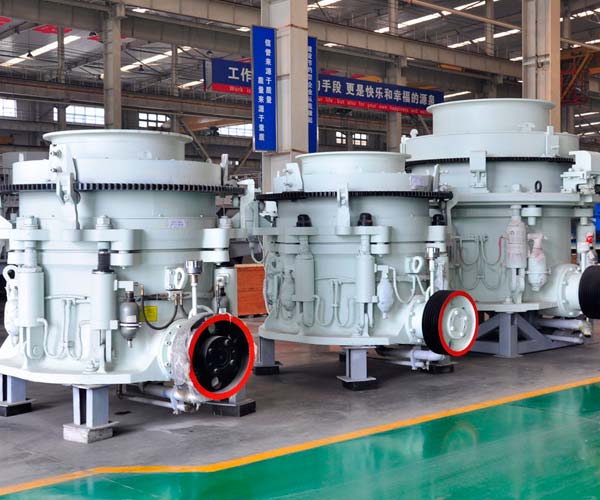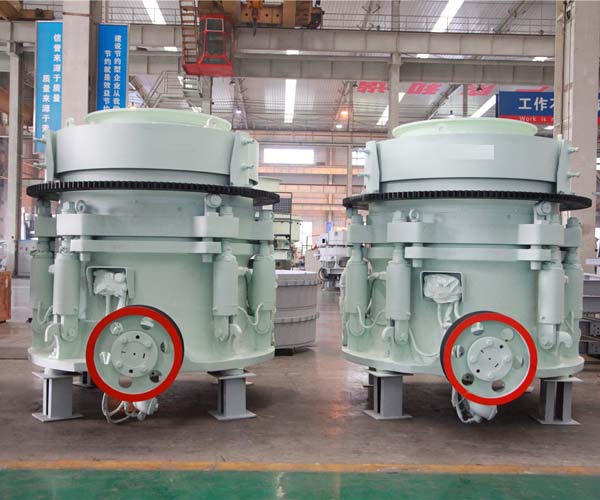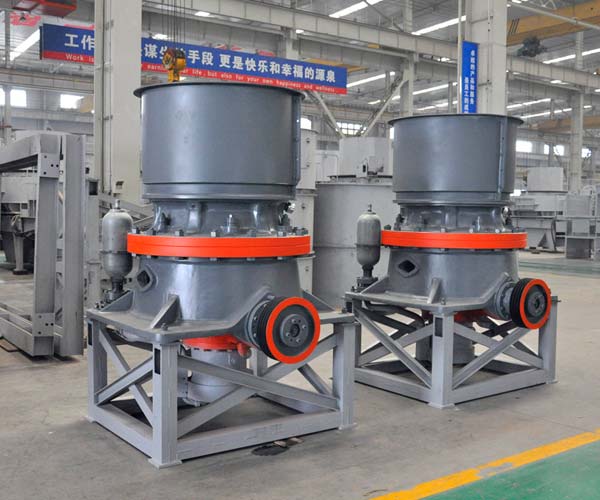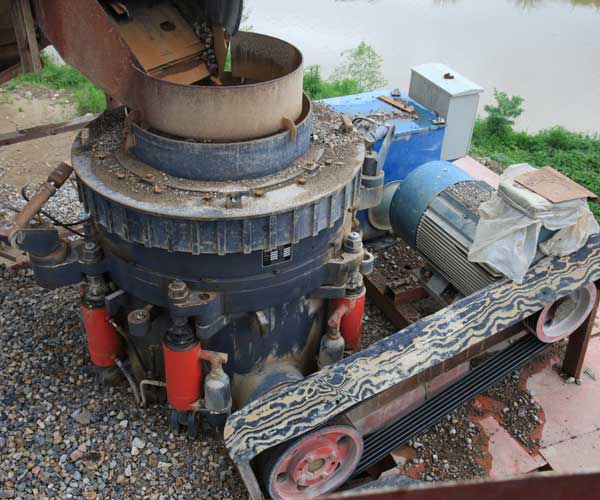
Cone crusher is a versatile and essential machine with applications in a wide range of industries, from mining and construction to recycling and environmental remediation. Its economic and operational advantages, such as efficient crushing, reduced operating costs, higher productivity, and adaptability, make it a valuable investment for companies seeking to improve their materials processing and reduce their environmental footprint.
24 Online Service

In the world of mineral processing and aggregate production, the concept of crushing holds a pivotal role. Crushing is the process by which rocks, ores, and various materials are reduced in size to facilitate their handling, transportation, and further processing. Among the many crushing machines available, cone crushers stand as one of the most vital and versatile tools for the job.
Cone crushers, as the name suggests, are crushers that employ a cone-shaped mantle and a concave liner to crush material between them. Their primary purpose is to break down larger rocks, ores, and other materials into smaller, more manageable pieces. These smaller pieces can then be processed further for various applications, such as construction aggregates, road building materials, and mineral extraction.
The process begins with the material being fed into the top of the crusher. As the material is gradually crushed between the mantle and the concave liner, it is forced to pass through a narrow opening at the bottom, which is the crushing chamber. The size of the final crushed product is determined by the width of this chamber and can be adjusted by varying the gap between the mantle and the concave liner. Cone crushers are renowned for their ability to produce well-shaped and finely crushed materials, making them ideal for many applications.
Understanding the inner workings of a cone crusher requires familiarity with its basic components:
The mantle is the inner, movable part of the cone crusher. It is positioned directly over the crushing chamber and plays a crucial role in the crushing process. The mantle gyrates, or rotates, causing the material to be crushed as it moves closer or farther away from the concave liner.
The concave liner is a fixed, outer shell that houses the mantle. It has a concave shape, which complements the mantle’s convex shape. Together, they create the crushing chamber where the material is processed.
The eccentric assembly consists of an eccentric shaft and a pair of bevel gears. It is responsible for the gyratory motion of the mantle. As the eccentric shaft rotates, it imparts a reciprocating motion to the mantle, which crushes the material.
The main shaft is connected to the mantle and transmits the power generated by the motor to the crushing chamber through the eccentric assembly.
This component includes an electric motor and a drive belt. The motor provides the necessary power to turn the eccentric assembly and, consequently, the mantle.
Hydraulic System (in hydraulic cone crushers): In hydraulic cone crushers, a hydraulic system is employed to adjust the gap between the mantle and the concave liner, providing precise control over the size of the final product. This system simplifies maintenance and allows for quick adjustments.
Cone crushers come in different types, each designed to suit specific applications and user requirements. Two of the most common types are the spring cone crusher and the hydraulic cone crusher.
This type of cone crusher utilizes a spring system to provide overload protection and adjust the discharge opening. The spring cone crusher is generally less expensive than its hydraulic counterpart, making it a preferred choice for smaller operations or those with budget constraints. However, it may lack the fine-tuning precision offered by hydraulic systems.
Hydraulic cone crushers employ hydraulic systems to regulate the gap between the mantle and concave liner. This results in precise control over the size and shape of the final product. Hydraulic cone crushers are known for their efficiency, reliability, and ease of maintenance. They are widely used in large-scale operations, where consistent product quality and high throughput are essential.
Additionally, there are variations within these two main types, each designed to address specific needs. For example, some cone crushers are optimized for secondary or tertiary crushing, while others are suitable for fine or coarse crushing.

In the world of mining and construction, where rocks and raw materials are transformed into valuable commodities, the cone crusher stands as an indispensable workhorse. Its ability to crush and shape rocks into smaller, more manageable pieces is a key step in the production of various materials, from aggregates used in construction to the fine sand needed for manufacturing. But how exactly does a cone crusher work, and what are the principles that drive its crushing prowess.
Before we dive into the intricacies of a cone crusher, let’s begin with some foundational knowledge. A cone crusher is a mechanical device used to reduce the size of large rocks and materials, typically as part of the process of breaking down hard materials such as ores and rocks. The machine operates on the principle of compression crushing, which means that it applies force to reduce the size of the material rather than using impact or attrition methods.
The journey of a material through a cone crusher starts at the feeding point. Large chunks of raw material, often mined from quarries or extracted from the earth, are loaded into the crusher’s hopper. The size of the material can vary significantly, from large boulders to finer aggregates.
Once the material is loaded into the hopper, it is gradually fed into the crushing chamber. This is where the first major player comes into action: the eccentric shaft. The eccentric shaft is a key component of the cone crusher, located beneath the crushing chamber. It is, as the name suggests, eccentric, meaning it is not aligned with the centerline of the crusher.
The eccentric shaft rotates, causing the main shaft, which is connected to it, to move in a circular motion. This motion generates a crushing force, compressing the material within the crushing chamber. The eccentric shaft’s unique design allows for a continuous and uniform crushing process, ensuring efficient material reduction.
The material, now subjected to intense compressive forces, travels upward through the crushing chamber. As it moves closer to the top of the chamber, it encounters two crucial components: the mantle and the concave.
The mantle is a fixed part of the cone crusher, situated at the top of the crushing chamber. It is conical in shape and serves as a protective liner for the chamber. The concave, on the other hand, is a moveable component that sits directly beneath the mantle. Together, the mantle and concave create a crushing cavity that narrows as it extends upward, forcing the material to be crushed into a smaller and smaller space.
The interaction between the rotating mantle and the stationary concave is what truly accomplishes the crushing process. The eccentric motion of the main shaft ensures that the material is constantly being compressed between these two components. The resulting pressure fractures and breaks down the material, reducing it to smaller-sized pieces.
The cone crusher’s ability to produce different sizes of crushed material is a valuable feature. This versatility is achieved by adjusting the distance between the mantle and the concave. By changing this gap, often referred to as the closed side setting (CSS), the operator can control the final size of the crushed product. Smaller CSS settings yield finer materials, while larger settings produce coarser output.
As the crushed material reaches the bottom of the chamber, it is expelled from the crusher through a discharge chute. The size of the material at this point is determined by the CSS setting. If the operator has set a finer CSS, the resulting material will be finer, and vice versa.
The material that emerges from the discharge point of the cone crusher is the final product. It can be in the form of smaller rocks, gravel, sand, or any other size and type of material the application demands. This final product can be used for various purposes, including construction, road building, and as feedstock for further processing in industrial applications.

Cone crushers come in various sizes and configurations, and their capabilities can be adjusted to suit specific crushing needs. Their adaptability is one of the key reasons they find applications in a wide range of industries.
Crushing of Ore: In mining operations, cone crushers are crucial for reducing the size of large rocks and ores. They are used to process materials like iron ore, copper, gold, and more. Cone crushers break down the raw materials into smaller, more manageable sizes, making them suitable for further processing.
Aggregate Production: Cone crushers are widely used in quarrying and aggregate production, where they help crush and shape rocks into the desired sizes for construction and infrastructure projects.
Road Construction: Cone crushers are vital for preparing aggregate materials used in road construction. They produce uniformly sized materials that improve the durability and longevity of road surfaces.
Building Construction: In the construction of buildings and infrastructure, cone crushers are used to crush and shape materials like concrete, granite, and limestone for various applications.
Concrete and Asphalt Recycling: Cone crushers are valuable assets in recycling plants where they break down old concrete and asphalt into reusable materials. This not only reduces waste but also saves resources by repurposing existing materials.
Crushing Rock and Gravel: In quarries and aggregate production facilities, cone crushers are the primary crushers used to process raw materials, from limestone to basalt, into the desired sizes for construction and infrastructure projects.
Sand Production: Cone crushers are also used to produce sand by crushing rocks into finely graded particles, which is an essential ingredient in the construction industry.
Steel and Non-Ferrous Metal Production: Cone crushers are employed in the processing of raw materials for metal production. They play a pivotal role in reducing the size of raw materials like iron ore and copper concentrate before they are smelted and refined.
Waste Remediation: In the field of environmental remediation, cone crushers can be used to crush and reduce the size of waste materials, making them easier to handle and process.
Silica Sand Processing: Cone crushers are essential in the production of silica sand for the glass and electronics industries. They crush and refine quartz into the high-purity silica required for manufacturing glass, optical fibers, and semiconductors.
Now that we’ve established where cone crushers are crucial, it’s time to explore the economic and operational advantages of investing in these versatile machines.
Our Projects
Copyright © ZENITH, All Right Reserved.
